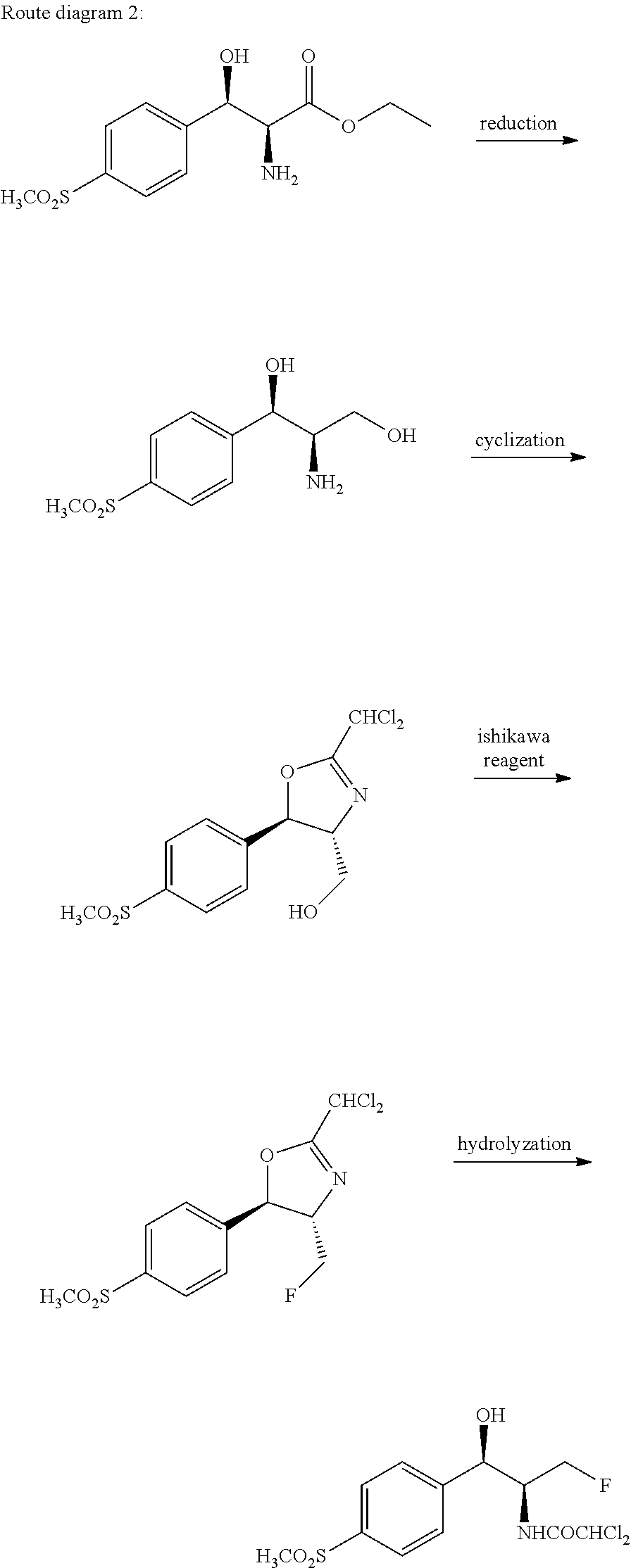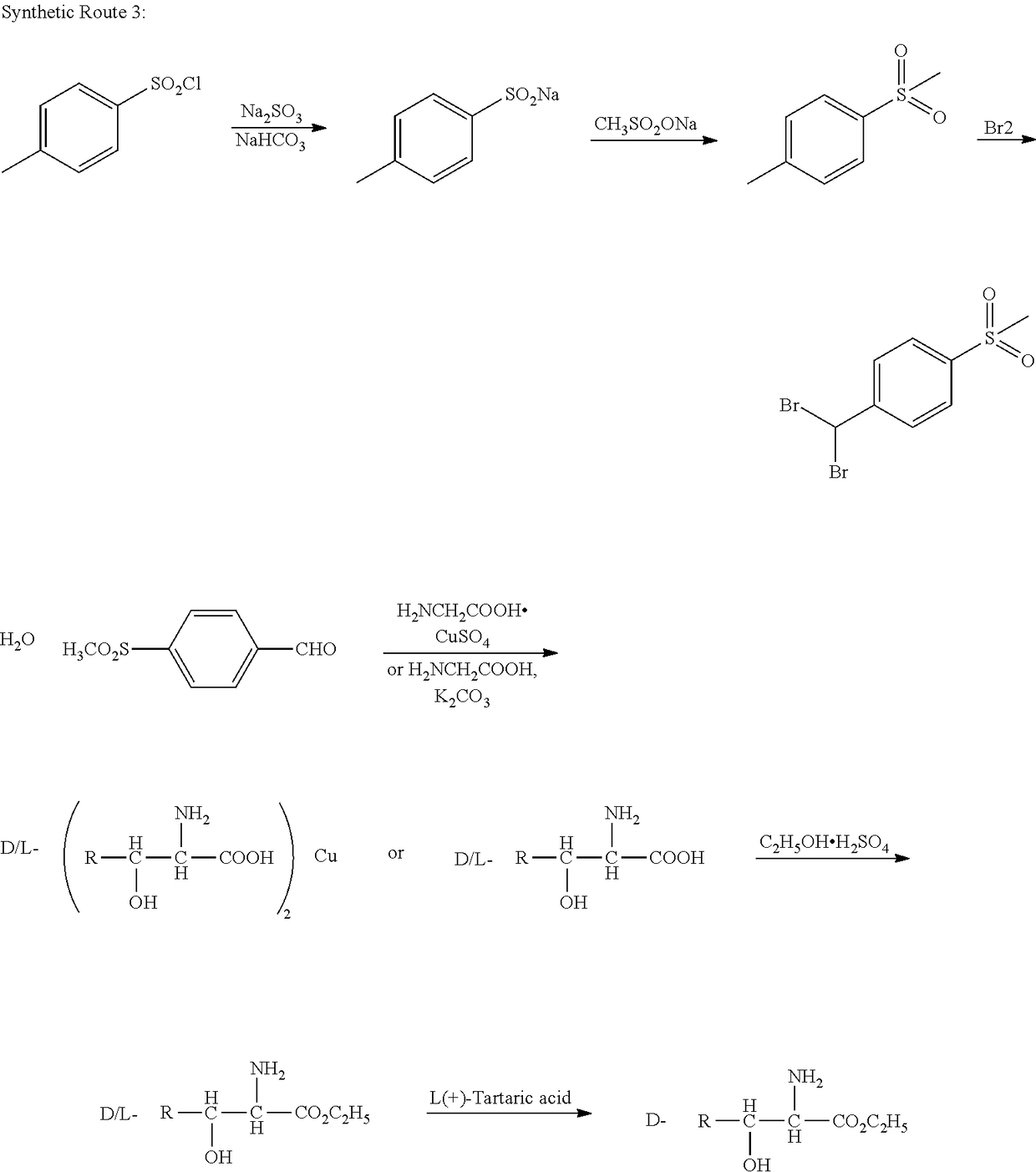Florfenicol synthesizing method
a technology of florfenicol and synthesizing method, which is applied in the field of synthesizing method of veterinary drug florfenicol, can solve the problems of high treatment cost of waste water, severe equipment corrosion, and time-consuming production and operation
- Summary
- Abstract
- Description
- Claims
- Application Information
AI Technical Summary
Benefits of technology
Problems solved by technology
Method used
Image
Examples
embodiment 1
[0080]Synthesizing 3-chloro-1-[4-(methylmercapto)phenyl]-1-acetone: adding aluminum trichloride (357 g, 2.68 mol) and 2000 ml of dichloromethane (pre-dried by means of anhydrous calcium chloride) into a 5 L reaction kettle at the room temperature; allowing the system to access a drying tube; stirring; pouring 3-chloropropionyl chloride (372 g, 2.93 mol) into a reaction bottle; cooling to 0 DEG C. by means of an ice bath; dropwise adding thioanisole (277 g, 2.23 mol) in 2 hours; after the dropwise addition is completed, transferring the reaction bottle into an oil bath; heating to 25 DEG C.; performing the reaction for 1 hour-3 hours; and monitoring by TLC until the reaction is ended. After half solvent is evaporated in a decompressing manner, the reaction solution is poured into the 10 L reaction kettle with 5 L of ice water, the reaction solution is stirred while being poured, after being completely added, the reaction solution is stirred for one hour, a great amount of solids are ...
embodiment 2
[0082]Synthesizing the compound 2-bromo-3-chloro-1-[4-(methylmercapto)phenyl]-1-acetone: adding 3-chloro-1-(4-(methylmercapto)phenyl)-1-acetone (160 g, 745 mmol) and 1800 ml of dichloromethane (pre-dried by anhydrous calcium chloride) into a 5000 ml three-opening bottle, and stirring; dropwise adding 40 ml of bromine (125 g, 780 mmol) and 200 ml of dichloromethane; uniformly stirring and mixing; then pouring into a constant-pressure dropping funnel; and placing the dropping funnel onto a reaction bottle. The reaction bottle is cooled in an ice-water bath, when the solution temperature is dropped to 0 DEG C., the dichloromethane solution of the bromine begins to be dropped, the temperature is kept at 0 DEG C., after the solution is completely dropped in 1 h-2 h, the temperature is kept at 0 DEG C. to facilitate the reaction, the TLC tracking is performed, after being completely dropped, the solution reacts for 1 hour, and the complete reaction is detected by means of TLC. A sodium bi...
embodiment 3
[0084]Synthesizing the compound 2-bromo-3-chloro-1-[4-(methylsulfonyl) phenyl]-1-acetone: adding 160 g of 2-bromo-3-chloro-1-[4-(methylmercapto)phenyl]-1-acetone and 600 g of acetonitrile into a 2500 ml three-opening bottle; stirring to dissolve the raw material; adding 5 g of catalyst Na2WO4.2H2O; dropwise adding 375 g of 30% hydrogen peroxide; when the hydrogen peroxide is dropped, controlling the temperature in the reaction solution not to be higher than 60 DEG C.; after the hydrogen peroxide is completely added, performing the reaction for 16 hours at the room temperature; sampling, and monitoring by means of TLC or HPLC; after the reaction of the raw material is completed, quenching the reaction by adding 500 g of water; decompressing and spinning to remove a majority of acetonitrile solvent; precipitating a great amount of solids; after the solids are sucked and filtered, leaching the solids multiple times by utilizing 500 ml of water; and drying the solids to obtain 162 g of ...
PUM
| Property | Measurement | Unit |
|---|---|---|
| weight ratio | aaaaa | aaaaa |
| weight ratio | aaaaa | aaaaa |
| molar ratio | aaaaa | aaaaa |
Abstract
Description
Claims
Application Information
 Login to View More
Login to View More - R&D
- Intellectual Property
- Life Sciences
- Materials
- Tech Scout
- Unparalleled Data Quality
- Higher Quality Content
- 60% Fewer Hallucinations
Browse by: Latest US Patents, China's latest patents, Technical Efficacy Thesaurus, Application Domain, Technology Topic, Popular Technical Reports.
© 2025 PatSnap. All rights reserved.Legal|Privacy policy|Modern Slavery Act Transparency Statement|Sitemap|About US| Contact US: help@patsnap.com



